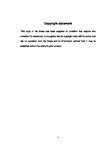Lipopolysaccharide in marine bathing water; a potential real-time biomarker of bacterial contamination and relevance to human health
| dc.contributor.supervisor | Simon, K. Jackson | |
| dc.contributor.author | Sattar, Anas Akram | |
| dc.contributor.other | School of Biomedical Sciences | en_US |
| dc.date.accessioned | 2015-01-05T09:19:57Z | |
| dc.date.available | 2015-01-05T09:19:57Z | |
| dc.date.issued | 2014 | |
| dc.identifier | 10250431 | en_US |
| dc.identifier.uri | http://hdl.handle.net/10026.1/3185 | |
| dc.description.abstract |
The quality of marine bathing water is currently assessed by monitoring the levels of faecal indicator bacteria. Among other drawbacks, results are retrospective using the traditional culture based methods. A rapid method is thus needed as an early warning to bathers for bacterial contamination in marine bathing waters. Total lipopolysaccharide (LPS) was chosen here as a potential general biomarker for bacterial contamination. Levels of total LPS, measured using a Kinetic QCL™ Limulus Amebocyte Lysate (LAL) assay, highly correlated with enumerated Escherichia coli and Bacteroides species. Levels of LPS in excess of 50 EU mL-1 were found to equate with water that was unsuitable for bathing under the current European Union regulations. Results showed that monitoring the levels of total LPS has a potential applicability as a rapid method for screening the quality of marine bathing water. More importantly, the LAL assay overcome the retrospective results when using culture based assessment since the LAL assay takes less than 30 minutes. Although false positive events were not detected, the occurrence of a false positive has been hypothesised, hence a more specific faecal biomarker was also investigated. LPS of five Bacteroides species (B. fragilis, B. caccae, B. ovatus, B. xylanisolvens and B. finegoldii) isolated from marine bathing waters samples were successfully profiled and showed high similarity between isolates in LPS gel electrophoresis banding pattern. Similar results were shown when investigating the endotoxic activity of Bacteroides species with the Kinetic QCL™ LAL assay. The potential biological relevance of Bacteroides LPS was also investigated in cell culture models indicating that Bacteroides showed similar induction of proinflammatory cytokines (TNF-α, IL-6 and IL-1α) and generally the biological activity was approximately 100 fold less than E. coli LPS. In addition, an ELISA assay was designed for the detection of Bacteroides LPS. Results showed that the Bacteroides LPS has a high potential to be used as a faecal biomarker, however, further work is required to develop a fully functional assay. The potential biological relevance of LPS present in contaminated bathing waters was also investigated in cell culture models. Results showed that there is a significant difference in the production of proinflammatory cytokines in comparison to “clean” bathing waters. Thus, results suggest that the European Directive regulations should be extended to cover the levels of total LPS in bathing waters to assure safety to the users of marine recreational water. | en_US |
| dc.language.iso | en | en_US |
| dc.publisher | Plymouth University | en_US |
| dc.subject | Endotoxin | en_US |
| dc.subject | Human health | en_US |
| dc.subject | Lipopolysaccharide | en_US |
| dc.subject | Rapid assay | en_US |
| dc.subject | Bacteria | en_US |
| dc.subject | Molecular Biology | en_US |
| dc.subject | Bathing seawater | en_US |
| dc.subject | cytokines | en_US |
| dc.subject | Bacteroides | en_US |
| dc.subject | Escherichia coli | en_US |
| dc.subject | Enterococci | en_US |
| dc.subject | Total coliform | en_US |
| dc.subject | Cell Culture | en_US |
| dc.subject | Monocyte | en_US |
| dc.subject | Macrophage | en_US |
| dc.subject | MPI | en_US |
| dc.subject | MM6 | en_US |
| dc.subject | Biomedical sciences | en_US |
| dc.title | Lipopolysaccharide in marine bathing water; a potential real-time biomarker of bacterial contamination and relevance to human health | en_US |
| dc.type | Thesis | |
| plymouth.version | Full version | en_US |
| dc.identifier.doi | http://dx.doi.org/10.24382/1522 | |
| dc.identifier.doi | http://dx.doi.org/10.24382/1522 |
Files in this item
This item appears in the following Collection(s)
-
01 Research Theses Main Collection
Research Theses Main


